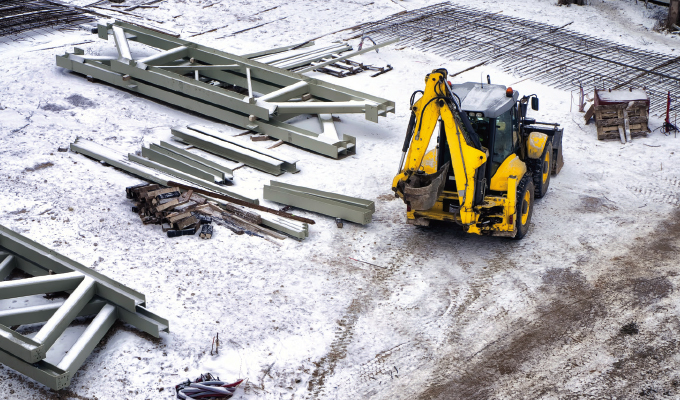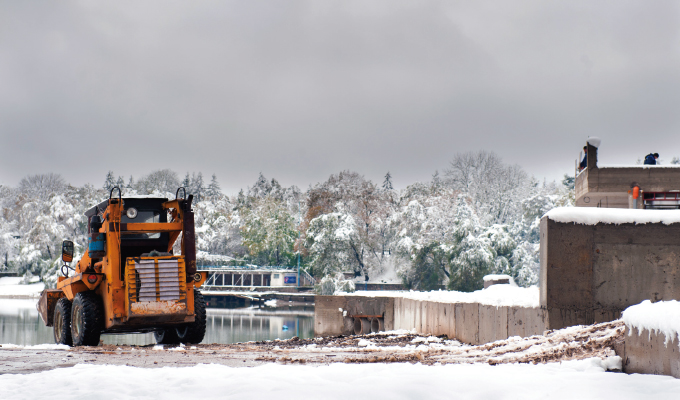Cold weather, snow, and ice pose significant safety challenges for contractors and construction companies, and indoor operations can also produce potentially hazardous conditions. Winter jobsites demand extra vigilance and risk management procedures.
As a property and casualty insurer for thousands of builders, developers, and property owners, Selective Insurance is familiar with common safety issues during cold weather construction. A combination of on-site safety best practices and Builders Risk insurance can help keep your employees safe and your project on track this winter.
OUTDOOR WINTER HAZARDS
Outdoor construction sites can be risky: heavy machinery, loose materials, scaffolding, and tools pose safety hazards. Seasonal conditions can add additional risks.
Slip-and-fall incidents are common when there is snow and ice on the ground. Businesses must clear high-traffic areas to help keep workers safe.
Shovel pathways and parking areas for the work site regularly. Keep buckets of sand and salt nearby, with a scooper readily available. Check paths and parking areas throughout the day. Contractors should also look out for trip-and-fall hazards buried under the snow.

INDOOR WINTER HAZARDS
While outdoor hazards are often apparent (e.g., snow on the ground) and simple to remove, indoor hazards can be harder to detect and prevent. These vary from location to location and depend upon building layout, the goods and materials stored within, and other factors. Some of the most common indoor winter jobsite hazards are:
Chemicals.
Chemicals at jobsites pose unique risks. Besides inhalation or skin exposure dangers, improperly stored chemicals can fuel fires in buildings and vehicles. Job sites that have chemicals with harmful vapors or air pollutants require additional ventilation and personal protective equipment for workers in the winter months. Give your employees Material Safety Data Sheets and train them to follow the instructions.
Sawdust.
Sawdust can be a significant issue during winter construction, when much of the cutting, sanding, and grinding work moves indoors, where there is less natural ventilation. Dust collection bags on equipment can help reduce the amount of airborne particulate.
Clutter.
Indoor accumulation of stored goods (or even just trash) can be problematic because of its potential to be ignited by temporary heaters. Clearance around heat sources and housekeeping is critical during the winter.
Safety Stations.
In a site where eyewash stations are required, contractors must ensure the nozzles and contents do not freeze. Frozen contents may expand and break their container, rendering them inoperable or unsterile.
Air Quality.
Reduced air circulation because of closed doors and windows, and more construction dust in the air, can negatively impact indoor air quality.
COLD WEATHER SAFETY RISKS
Winter weather conditions can create risks unrelated to daytime construction work at jobsites. For example, unattended structures can provide attractive shelter for unauthorized persons such as homeless people or those looking for a location to conduct illicit activity.
Contractors should make reasonable efforts to restrict entry. Security measures such as fences, guards, security cameras, and passive lighting control help keep unauthorized people out. Avoid leaving open 55-gallon drums at the jobsite, as these can entice trespassers to start fires for heat.
The weather itself can also pose significant risks. Fall and winter winds can cause crane or wall collapses—especially when compounded by the weight of snow or ice. Employees should also use caution when carrying large flat objects outdoors, like plywood sheets, that can catch a gust of wind and cause the employee to fall or lose control of the object.
Claims for events away from jobsites often involve vehicle collisions. Contractors, especially those involved in heavy construction, frequently drive large vehicles and may have to navigate narrow streets or unpaved access roads near construction sites. Such circumstances require careful driving at any time, but much more so in the winter because of ice, snow, and fewer daylight hours.
Finally, spontaneous combustion is a frequent winter worksite hazard. For example, rags soaked in ignitable liquids like stains or linseed oil (used for finishing floors) may not be stored correctly and catch fire.
BUILDER’S RISK INSURANCE
The precautions above can help contractors avoid many winter worksite hazards. However, if an incident does occur, Builders Risk insurance can help protect your company and keep the project going.
Builders Risk insurance provides financial protection for stakeholders in commercial or residential construction or renovation projects. It can provide coverage in connection with property damage or loss caused by hazards like fires, storms, and theft, which typically extends to construction materials and soft costs incurred by delays.
Every contractor needs Builders Risk insurance, but not all policies are created equal. Selective offers unique value-added services, such as equipment breakdown coverage, for policyholders at no extra cost.
CLOSING THOUGHT
Winter presents a host of safety issues at construction sites. By being aware of them, taking precautions, and including a comprehensive insurance policy, contractors can help minimize their effects, maintain productivity and meet the project’s goals.
Selective Insurance Group, Inc. is a holding company for 10 property and casualty insurance companies rated “A+” (Superior) by AM Best. Through independent agents, the insurance companies offer standard and specialty insurance for commercial and personal risks and flood insurance through the National Flood Insurance Program’s Write Your Own Program. Selective’s unique position as both a leading insurance group and an employer of choice is recognized in a wide variety of awards and honors, including the Fortune 1000 and being named a Great Place to Work® in 2021.
About the Author:
Scott E. Smith is vice president, director of safety management services at Selective Insurance. He joined Selective in January 2019. Before that, he served as Deputy Field Officer for North American Risk Engineering Services at Chubb. Mr. Smith has designations as an Associate in Risk Management and a Certified Risk Manager. For more, visit www.selective.com.
Modern Contractor Solutions, February 2022
Did you enjoy this article?
Subscribe to the FREE Digital Edition of Modern Contractor Solutions magazine.



